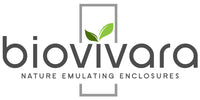In this five-part series, you'll learn how to pick out an enclosure that will help you avoid the common problems in enclosed habitats and instead create a naturalistic habitat that is easy to manage and reliably mimics your desired natural ecosystem.
Good vs Great Enclosures
Not many people realize that an enclosure can have a significant impact on the success or failure of the habitat within it.
A good enclosure will not be a mere box to hold your plants and animals, but a mechanism for helping your plants and animals thrive.
But, a great enclosure will make this process easy for you, requiring little time and effort to maintain - all while helping your habitat become more beautiful and stable over time.
If your enclosure can get a "yes" to the 5 questions in this series, then you've got a keeper.
Today, we address the #1 problem with most enclosures on the market today...
QUESTION #1: IS IT ABLE TO REPRODUCE THE NECESSARY ENVIRONMENTAL CONDITIONS?
Captive plants and animals thrive best in enclosures that simulate their natural environments.
So, if you know what functions to reproduce, you can recreate the natural environment your plants and animals need to thrive.
Here’s what you need in an enclosure to consistently simulate natural environments:
1. Reproduce Air Cycles
In the wild, air moves naturally with humidity and temperature changes, animal movement, and from wind. It is important to actively simulate natural air movement in your enclosure with fans.
2. Reproduce Water Cycles
Nature cycles and purifies water through rainfall, filtration through soils and substrates, purification from plants that absorb and sequester toxic compounds, proper balance of beneficial microbes that consume waste, and so forth. You can recreate these systems with an active water cycling system that uses a pump, tubing, and misting system.
3. Substrate and soil composition
A good soil and substrate composition will help cycle your water, keep the upper soils from being too wet, and to give plenty of surface area for growth of beneficial, waste consuming microbes. Make sure your enclosure allows you to have at least three inches of substrate at the bottom.
4. Customizable Lighting Options
Your enclosure should have flexible lighting options or allow you to add the lights best suited for your application. If lighting is permanently fixed into the design, make sure the lights have the correct lighting levels, intensity, and can be set on a timer to make creating a day-night cycle easier.
5. Easy Temperature & Humidity Management
Look for an enclosure that has minimal screens or openings to the air. Lower air exchange will make it easier to maintain the desired temperature and humidity levels in your enclosure.
Some air exchange is desirable since a completely closed system can create other problems. But, a low air exchange rate helps your enclosure have more consistent temperature and humidity levels regardless of the environment around it.
Also, consider using an acrylic enclosure. Acrylic has many benefits, one of which is that it is 20% more insulating than glass, so temperatures are more stable.
Up Next - Part 2: Is it safe?
